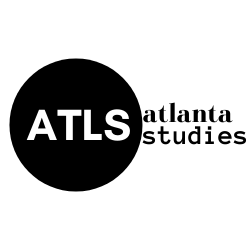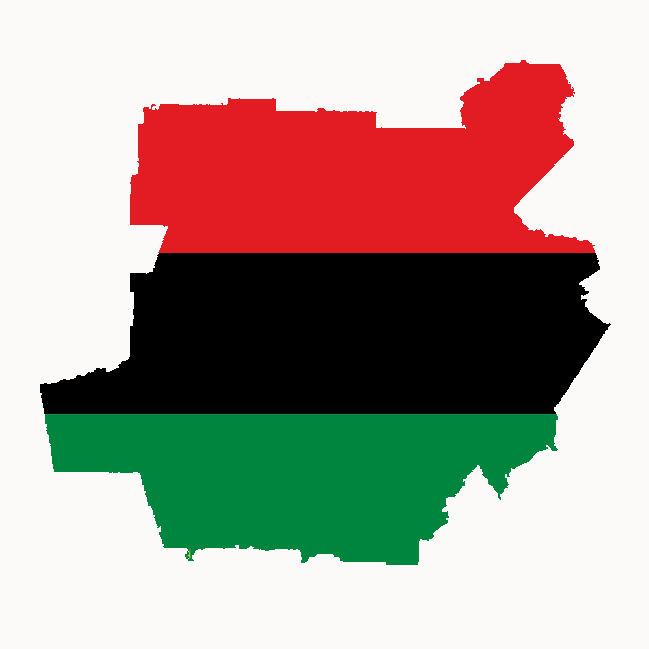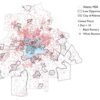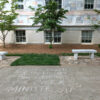Comprising the city of Atlanta and twenty surrounding counties, the Atlanta region is a physical topography with economic, social, and political meaning.
Nested within broader spatial systems and historical ideations of place such as “The South,” the “Southeast,” and the “Cotton Belt,” Atlanta’s destiny is ever linked to its structural and symbolic positioning within larger regional configurations. The conventional cartography of Atlanta regionalism looks like the map below. Within the outlines of ostensibly hard political boundaries, the blank spaces on this map could be filled in with census figures, health statistics, and metrics of economic output and wealth transfer that index a litany of racialized deficits and spatialized inequalities. This is only one possible model of regional representation, but a powerful one that informs politics, policy, and social outcomes in very concrete ways.
What this map obscures, however, are hidden social assets – cultural knowledge, networks of kinship and friendship, sites of remembrance and resistance – embedded within actual, physical places and bodies; complex assets that often draw upon translocal and transnational black resources and circuitries. For, in connection to its status as a Black Mecca, the future of Atlanta is also determined in large measure by its location within an African Diasporic network of circulating peoples, cultures, goods, and services – a sphere that extends beyond the geographical and representational limits of conventional southern regionalism. Layering the better-known story of US African American experience in Atlanta, the region has also become a place where multiethnic and multinational Africana communities converge and forge mutually constitutive black identities and spaces. Like the region itself, Black Atlanta is always under construction.
Adapted from a plenary panel presentation at the 2018 Atlanta Studies Symposium,1 this video roundtable responds critically to standard renditions of city and region by exploring regionalism through the lens of black spatial experience. The questions raised and evidence proffered address the research potential of diaspora-centered concepts as tools for understanding the social construction of space and place in our rapidly pluralizing region. Recognizing black diasporic populations in the metro area as a product and process of ongoing racial, gendered, and spatial formations, the panelists highlight the racialization of black immigrants, the moral solidarities of transnational black religious communities, the involuntary shape-shifting and space-sifting among displaced black downtown populations, and the creation of black queerspace in the metro region. Such inquiries into the spatialization of metro Atlanta’s varied black ethnoscapes, and the hidden assets therein, are ultimately relevant to the future of the region as a whole. Black people have been in what is now the Atlanta metro region in significant numbers for generations and are not going anywhere anytime soon. Unlike some metropolitan areas with shrinking black populations, metro Atlanta continues to swell, as black folks travel overland and oversea to seize upon the Black Mecca experiment. Indeed, despite gentrification, urban revitalization, and the generalized precarity induced by neoliberalism, Black Atlanta is not disappearing. Rather, new geographies or mappings of black life are in the process of being created, revised, and shifted in ways that shape and are shaped by urbanization processes.
Foregrounding transitory and transboundary black worlds, our panel participants thus explore how black residents construct regional space and identity as well as how the region signals black space – an imagined geography of racial belonging – to peoples of African descent living elsewhere. This discussion helps us to understand how (some of) the varied diaspora communities have evolved, overlap, and intersect within the region; how African descent peoples construct and understand metro Atlanta spatially; and how these mobilities, meanings, and practices have contributed to what black feminist geographer Katherine McKittrick calls a “black sense of place.”2
Some of us are not dedicated scholars of Atlanta and so make no claims of authority on the rich body of literature about the city. Rather, our scholarly interests stretch across Africana studies, Atlantic history, urban ethnography, cultural geography, and feminist theory and our complementary backgrounds as scholars invested in comparative and transnational black studies urge us always to think in terms of blackness across borders. Consequently, as researchers and teachers in this city, we are constantly in search of multidisciplinary approaches to Atlanta that accommodate the diversity of the global African diaspora. In so doing, we seek to enrich our capacity to articulate local diasporic social realities as well as regional diasporic terrains with greater complexity and nuance.
With this motivation in mind, each roundtable speaker sketches a type of “regional black geography” based on their own research, identity, and experiences in response to the following questions: Who occupies this black geography and provides its social base? What are its spatial attributes, limits, and historical vectors? What identity claims and forms of agency explain both the coherence of this diaspora ‘community’ and dynamics of contention within it? Finally, what kind of research agenda would you propose pertaining to the study of the particular black socio-spatial formation so named?
The video sequence begins with three speakers, Asia Leeds (Spelman College), Mark Bilal King (Morehouse College), and Regine O. Jackson (Agnes Scott College), who complicate metro Atlanta’s traditional black cultural cartography by invoking diasporic histories and conceptual frames that center the place-making experiences and knowledge of “transnational” African diasporic communities in Atlanta. We then turn, in the subsequent videos with Justin Hosbey (Emory University) and Aretina Hamilton (Interlochen Center For the Arts), to discussions of “traditional” African American populations with longstanding southern roots, whose navigation of protracted economic crisis, urban displacement, and the interlocking forces of racism, (hetero)sexism and homophobia, informs their black place-making agency and vulnerability. As a collective project, we thus endeavor to sketch some of the emergent, even insurgent black geographies of the region, and seek to offer a set of provocations in support of black diasporic geographical research that maps spaces and modes of black place-making in an ever-evolving Atlanta region.
Asia Leeds on “Diaspora” as a Framework for the Study of Black Life
Q: It’s easy for people to think of places like Miami and New Orleans as U.S. southern cities with historical and contemporary connections to South American and Caribbean cities and flows. Considered exceptional to mainstream U.S. cultural logics in many ways, we often imagine those places as plugged into a larger Global South. Atlanta’s history is obviously very different from those places, but do you think that Atlanta’s relationship to a larger hemispheric South and Caribbean diasporic sphere deserves better description?
Q: Can you clarify what the term “circum-Caribbean” means? And what might be the value of recasting Atlanta’s regional signification beyond the U.S. Southeast to consider also the city’s positioning as an important node of black economic and cultural agency within a circum-Caribbean politics of blackness?
Q: When I think about the intellectual genealogy of scholarship about Black Atlanta, I always return to W.E.B. DuBois, whose turn-of-the-century sociological laboratory at Atlanta University applied innovative analytics and research methods to the study of African American populations. But throughout his career, DuBois also analyzed black development in a comparative context. He connected U.S.domestic racism to globalized oppressions affecting people of color in Africa, Asia, and the Caribbean. So, the notion of thinking on a diasporic scale is not a new thought-line; yet, the analytical power of diaspora theory has continued to evolve over time. As a professor of African Diaspora Studies, and being at Spelman College, what do you think that current iterations of diaspora theory offer as tools for the study and teaching of black lives in Atlanta?
Mark Bilal King on Africana Muslims in Atlanta
Q: You have been examining the lives of Africana Muslims in the metro area. Indeed, you have also been living as one. For Africana Muslims, Atlanta is no mecca, in the literal sense, but it has become an attractive place of settlement and of transnational crossing. What can you tell us about the features of the Africana Muslim landscape?
Q: Do cultural differences create fault lines among these communities, as well as between African Muslims and African American Muslims?
Regine O. Jackson on African and Caribbean Immigrants in Atlanta
Q: As we’ve now heard from our other speakers, the black in Black Atlanta is not a settled category of identification. The proposition of Atlanta as a complex diasporic geography requires us to better understand black migrant subjectivities, social locations, and spatialities. Your work has examined Caribbean and African migrations to and circulations within the Atlanta region. Based on your own scholarship, how might we begin to make sense of the ethnic and national diversity among the black communities of Atlanta, and some of the ways that the spatial experiences of black immigrants may differ from those of “native” Black Atlantans?
Q: To your larger point that Black Atlanta has been shaped by multiple histories of migration, I sense that there is a need to create a diaspora-sensitive timeline for Atlanta migration studies. We seem to be missing a more complete urban migration analysis that captures both the internal movements of African Americans to Atlanta (e.g.: the reverse migration phenomenon) as well as international migrations. Do we yet have useful terminologies for or periodizations of this broader process of diaspora formation in Atlanta? What questions does your work raise toward addressing these gaps?
Justin Hosbey on Black Enclaves of Atlanta’s Westside: Loss, Memory, and Recovery
Q: We have so far discussed features of black transnationalism in Atlanta that connote specific patterns of people movement in the region. Transnational mobility – human, cultural, monetary, etc. – is part and parcel of capitalist globalization. At the same time, deindustrialization and global financial crisis have, in recent decades, debilitated Atlanta’s black working and middle classes by constraining the socioeconomic and spatial mobility of those who have lived here for generations. Reflecting on your own experiences as a native of Southwest Atlanta (a historically-black inner-city enclave), how have these broader processes and attendant intraracial shifts in wealth, class power, and social cohesion informed the contours and meaning of black space in West Atlanta?
Q: Keeping in mind what you referenced about the Westside’s black geography no longer being intact or legible in quite the same way as before, since moving back to Atlanta last year are there spaces of retreat you’ve observed that recall some of the old flavor? What has remained and what seems lost? From your perspective, how does McKittrick’s notion of “black sense of place” give us a language to think about what black folks do to claim and create space for themselves in times of crisis and displacement?
Aretina Hamilton on Queer Black Atlanta
Q: Marlon Bailey has defined black queer space “as the place-making practices that Black LGBT people undertake to affirm and support their non-normative sexual identities, embodiment, and community values.”3 Your past research has focused on African American lesbians and how they have created spaces of belonging in Atlanta. As the only formally trained geographer on the panel, could you gesture to the work that geographers are doing in theorizing race, sexuality, space, and place? And with your own research in mind, what kind of intervention does black queer geography present for Atlanta Studies?
About the Authors
Kali-Ahset Amen is formerly the Associate Director of the James Weldon Johnson Institute for the Study of Race and Difference at Emory University. Currently an Assistant Research Professor of Sociology at Johns Hopkins University and Associate Editor of the journal City & Community, Amen is also a curator of Africana experience in the Americas. Her research interests center on transnational processes of racialization and citizenship inequality in Central America, the Caribbean, and the U.S. South.
Asia Leeds is Assistant Professor of International Studies and co-director of the African Diaspora Studies minor at Spelman College. Her research and teaching interests include Afro-Central America, gender and Pan-Africanism, and Caribbean migrations. She is currently working on a book on race, citizenship, and belonging in Costa Rica titled Between Nation and Diaspora and an edited book on teaching African Diaspora Studies.
Mark Bilal King is Associate Professor of Sociology at Morehouse College. He teaches courses on Africana Muslims, and Migration and Entrepreneurship, among other subjects. Adding to his research portfolio on black families and masculinities, he is currently writing about the role of faith communities and discourse in the formation of Black American Diaspora communities.
Regine O. Jackson is Associate Professor and Chair of the Department of Sociology and Anthropology at Agnes Scott college. She is a migration scholar, whose teaching and research focus on American immigration, the Haitian diaspora, Caribbean and African immigrants in the U.S., and urban studies. Her current research focuses on Haitian émigrés in postcolonial Africa and on African and Caribbean immigrants in the (new) South.
Justin Hosbey is Assistant Professor of Anthropology at Emory University. His ethnographic work explores Black social and cultural life in the U.S. Gulf Coast and Mississippi Delta regions, focusing on the ways that southern Black communities articulate insurgent modes of citizenship that demand the interruption of racial capitalism.
Aretina Hamilton is a Cultural Geographer who focuses on issues of race, gender, and sexuality in the American South. Her research focuses on the symbolic and physical cartographies of the Black Queer South. In her graduate work, she spent nearly 4 years conducting ethnographic research in Atlanta. More recently her work has begun to focus on how state violence and racism transform everyday geographies into carceral sites of violence.
Notes
- Atlanta Studies Symposium 2018, “Atlanta: City + Region,” Emory University, April 20, 2018.[↩]
- Katherine McKittrick and Clyde Woods “No One Knows the Mysteries at the Bottom of the Ocean” in Black Geographies and the Politics of Place, Ed. Katherine McKittrick and Clyde Woods (Toronto: Between the Lines, 2007), 7.[↩]
- Marlon M Bailey, “Engendering Space: Ballroom culture and the spatial practice of possibility in Detroit,” Gender, Place & Culture: A Journal of Feminist Geography, 21, 4 (2014): 490.[↩]




